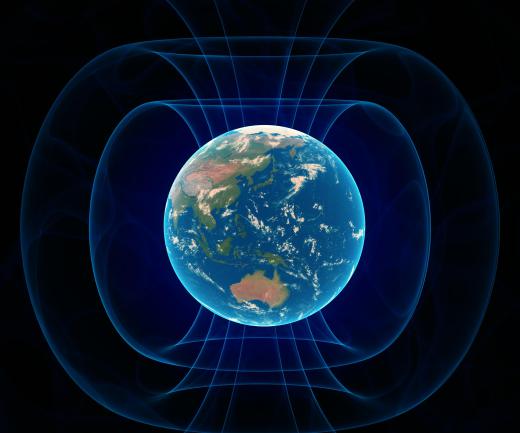What is an Electromagnetic Field?
 Mary McMahon
Mary McMahon
An electromagnetic field is a field which possesses magnetic and electrical properties and surrounds objects with an electrical charge. The field also interacts with charged objects within the field. Electromagnetic fields are present on a basic level across the universe, in varying degrees of strength. The Earth, for example, is surrounded by an electromagnetic field generated by the movement of electrons inside the Earth, and this field is taken advantage of every day when people use compasses to orient themselves. The behavior of such fields is determined by the wavelengths of energy generated, and the frequency of their oscillations. Long wavelengths oscillate at a low frequency, while short wavelengths oscillate at a high frequency.
Whenever voltage is present, an electric field forms. In a simple example, when a light is plugged into a socket but not turned on, a small electric field is generated. When the light is turned on, causing a flow of current, the movement of electrons creates a magnetic field. The electric field is still present, so an electromagnetic field is being generated. Changes in an electric field can generate magnetic activity, while changes in a magnetic field can generate electrical activity.

A classic example of an electromagnetic field is the field generated around high energy power lines. Many people have noted that they can feel a hum of energy around power lines, and studies have shown that the electromagnetic field which surrounds high energy power lines can actually impact the growth of plants inside the field, illustrating the way in which an electromagnetic field can act on charged particles inside the field.

The electromagnetic spectrum runs all the way from radio waves, which have long wavelengths and a low frequency, to gamma rays, with short wavelengths and a high frequency. Electromagnetic radiation on the higher end of the electromagnetic spectrum is known as ionizing radiation because it can remove electrons from the molecules and atoms they pass through. One area of the electromagnetic spectrum is of special interest: the range of visible light. When someone sees the orange of a carrot, for example, it is because the eye is sensitive to wavelengths reflected by the carrot.

Certain types of electromagnetic fields have been linked with health concerns. Several studies on cancer have shown that some childhood cancers have been linked with exposure to high energy electromagnetic fields. Even as an electromagnetic field causes health problems, however, it can also be beneficial. For example, in the medical community, people use x-rays, a form of electromagnetic radiation, to see the inside of the body, and lasers, another form of electromagnetic radiation, to perform surgery.
AS FEATURED ON:
AS FEATURED ON:
















Discussion Comments
The effects of electromagnetic waves on humans can vary depending on the type of wave and how powerful it is. Microwaves are quite strong and concentrated electromagnetic waves which work to heat objects in a microwave oven. This can be dangerous when used outside of a microwave.
The electromagnetic field of the earth seems to be generated by the two poles of the earth's rotation. These fields are what causes compasses to point north and can guide people to where they need to go on the surface of the earth by interacting with the field. Satellites are also guided by these systems, and keep to a regular orbit based on the rotation of the earth and the electromagnetic field.
Electromagnetic field theory is similar to gravitational field theory. The earth and all planetary bodies, as well as the sun, have both an electromagnetic field and a gravitational field which are structured similarly and conduct and interact with the basic forces of nature. The electromagnetic field of the sun, like its gravitational field, is unusually strong, and generates solar winds and causes auroras.
Post your comments